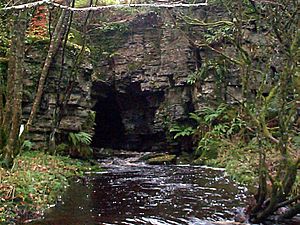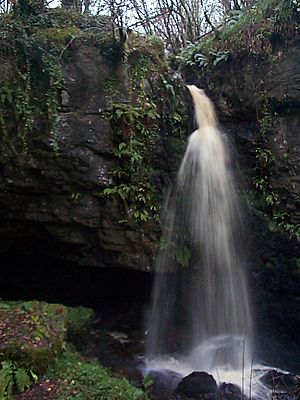Caves of the Tullybrack and Belmore hills facts for kids
The Caves of the Tullybrack and Belmore hills are a group of amazing underground caves. You can find them in the southwest part of County Fermanagh, Northern Ireland. This area is known for its special limestone landscapes, which are similar to the famous Marble Arch Caves Global Geopark nearby.
These caves are hidden beneath the hills of Tullybrack (which is about 386 meters high) and Belmore (about 398 meters high). There are three main cave systems here: Reyfad–Glenkeel, Noon's Hole–Arch Cave, and Boho Caves. Experts from the Northern Ireland Environment Agency say these caves are very important for the whole country.
The caves formed in ancient limestone rocks that are millions of years old. Over time, water slowly dissolved the rock, creating the passages and chambers we see today. Most of these caves and their features are protected as special natural areas. This means they are important places for nature and science.
Belmore Mountain Caves
Boho Caves
The Boho Caves are a group of caves including the main Boho Cave, Waterfall Cave, and Upper and Lower Ravine Caves. This cave system is the sixth longest in Northern Ireland. It's special because its passages follow natural cracks in the rock.
Aghnaglack Cave
This small cave is part of the Boho Cave system. It's a protected site because of its natural features. The cave formed in limestone rock. It has two passages, each about 8 meters long. One of these passages was made bigger a long time ago, like an ancient underground tunnel.
Aghnaglack Rising
This cave is also part of the Boho Cave system and is a protected area. It's made of limestone. If it's dry, you can crawl through this formation.
Pollnagollum, Coolarkan
This site is a protected area. It means "hole of the doves" in Irish. The cave is made of limestone with some cool rock formations. You can enter the cave where the roof once collapsed. A large waterfall flows into the cave here. The stream goes through the cave until it hits a pile of rocks that blocks the way. The water then comes out into the Aghanaglack River valley about 1.8 kilometers away.
Early cave explorers visited this cave a long time ago. One explorer, Henry Lyster Jameson, came in 1895 to collect animal specimens.
You can see pictures of Pollnagollum Coolarkan on Flickr: [1]
Tullybrack Caves
The Tullybrack area has another amazing cave system called Reyfad–Carrickbeg. The Northern Ireland Environmental Agency says this system is one of the most important underground limestone sites in Northern Ireland. This is because of its incredible rock formations and geological features.
Carrickbeg Rising Cave (Bunty Pot)
This cave is about 1 kilometer long and runs north to south. It's split into two parts. You can explore the main water passage. However, there's a 10-meter section filled with water that you can't easily get through. This cave is where water from four other major cave streams comes out.
Fairy Cave
This cave is a protected area. It might have been part of the main Reyfad cave system a long time ago. There's a small passage only 1 meter high that ends in a water-filled section. Beyond that, the passage is blocked by mud.
Ivy Hole
This is a protected sinkhole, which is a hole in the ground where water drains. It's one of two similar holes. A small stream flows into this sinkhole, which is about 10 meters deep. Scientists have found that the water from here comes out at Carrickbeg Rising.
Little Reyfad
This sinkhole is a protected site. It's at the bottom of a bowl-shaped hollow. You can go down about 7 meters to a floor of broken rock. Then, there's another difficult 3-meter drop to a base that's blocked by rocks and gravel.
Mad Pot
This sinkhole starts in peat and then goes into limestone rock. It has several levels of broken rock that lead to more passages. As the rock changes, the cave becomes more vertical. After some climbing, there's a 22-meter vertical drop. At the bottom, a crawl leads to a completely flooded section that is blocked by mud. Above this, there's a very tall chamber.
Murphy's Hole
This protected site is made of limestone. It's located at the north end of a dip in the ground. A waterfall drains into this sinkhole. It takes a lot of water during heavy rains. Scientists have used special dyes to show that the water from here comes out at Carrickbeg.
Oweyglass Caves
This protected cave is found in a limestone cliff. It's connected to a series of springs. The longest passage in this cave is about 15 meters long.
Pollbeg
This protected sinkhole is made of different types of limestone. It floods when there's a lot of rain.
Pollkeeran
This protected sinkhole is thought to be a collapsed cave roof. The fallen rocks have created a "choke hole" that blocks the way. Scientists have found that the stream that goes into Pollkeeran comes out 2 kilometers north at Carrickbeg Rising Cave.
Warning: This sinkhole is very dangerous. Only highly experienced cave explorers should try to go into it.
Pollmore (Poll Mór)
This protected shakehole (a type of sinkhole) has two places where water drains. It's surrounded by cliffs on three sides. When it rains a lot, the water can build up to 2 meters deep. The water from Pollmore also comes out at Carrickbeg Rising.
Pollnacrom
This protected cave is part of the main Reyfad system. It has a small, wet entrance. The cave has two shafts, 50 and 15 meters deep, that lead to the main stream passage. This passage goes for about 100 meters northwest before turning south. Explorers have gone about 600 meters into the cave until they reached a section that's impossible to pass. An attempt to explore this difficult passage led to a tragic accident in 1981.
You need permission from the landowner to visit this cave.
Polltullybrack
This protected cave is another major entrance to the Reyfad system. Its name means "hole of the speckled hillside" in Irish. The entrance is very tight through a sinkhole. However, it eventually opens up into a wider cave. The passage has many boulders and a deep pool. After that, there's 250 meters of difficult passage that ends in a submerged section where explorers have to duck under water. A short distance further, there's a 53-meter shaft. This is the longest known vertical drop in any Irish cave! The cave connects with the Reyfad system near the main chamber. Before that, there are chambers called the 'Grottoes'. These have beautiful calcite formations like stalactites, helictites, and cave curtains.
You need permission from the landowner to visit this cave.
Rattle Hole
This protected pothole is found in moorland. It has a single shaft that is 36 meters deep. This leads to a second chamber, which is another 25 meters deep. Both end in gravel. Even though explorers haven't found a way to go further, dye tests show that the water from here comes out at Carrickbeg.
Reyfad Pot (Pota Raith Fada)
This cave is considered the most important underground limestone site in Northern Ireland by experts. It's 193 meters deep and 6.7 kilometers long. This makes it the deepest cave system in Ireland and the second longest in Northern Ireland! This protected site is very active, with many calcite formations. It also has fossilized ancient sea creatures like brachiopods and crinoids. Scientists think this large cave area formed after the last ice age.
You need permission from the landowner to visit this cave.
Seltanacool Sinks
These three protected sinkholes are made of limestone. They are in the same dip in the ground as Murphy's Hole. Scientists believe these sinks connect to Carrickbeg Rising.
Knockmore Caves
Noon's Hole
Arch Cave
This cave is also known as Ooghboraghan. It's made of many different types of rock, including limestone and sandstone. You can also find other materials like breccia, chert, mudstone, and calcite here.
Aughakeeran Pot
This protected sinkhole is also called Pollaphylla or Pollasod. It has a large shaft that is 30 meters deep. There are also some crawling sections and short passages. These passages end at a crack in the rocks that can't be passed. Scientists think the stream that goes through Aughakeeran joins the water flow through Pollanaffrin.
Crunthelagh Sink
This protected sinkhole is made of limestone. Scientists believe the water flowing into this sink comes out in the 'High Noon's' part of the Noon's–Arch cave system.
Killydrum Sink
Lettered Cave (Inscribed Cave)
This small cave is about 50 meters from the top of Knockmore mountain. It's important for history and archaeology. Some parts of it were even made by people. The cave is named because of the old art and writing on its walls. It was studied by explorers in the late 1800s and is now a protected ancient monument.
Old Barr Sink
This protected sink is in a forest. A small stream flows into it and disappears in several places. Scientists believe the water from this stream goes into 'Inlet 1' near 'Artie's Chamber' in the Noon's–Arch cave system.
Pollanaffrin
This protected sinkhole is made of limestone. A large river flows into this pothole when it rains a lot. The cave has many twists and drops. It's quite long before it reaches a point where you can't go any further. Scientists think the water from this system goes into Noon's Hole.
Seltanahunny Sink
This protected sink is part of the Noon's Hole–Arch Cave complex. It has a narrow passage that goes for 12 meters to a waterfall and a section where you have to duck under water. Scientists think the water from this sink also joins the Noon's Hole drainage system.
|




